Filmed December 1985
THE PAPER CHASE: The Graduation Year! The series that had followed star student James T. Hart from his entrance into law school on CBS in 1978 was entering its fourth and final season on cable network Showtime. And a short season it was to be. The network had ordered only 5 episodes, the final one to be a two-hour special. I was booked to direct 2 of the episodes – the closing two-hour GRADUATION and A WOUNDED HART, which, although it was not the first episode filmed, it was the opener for the final season.
For John Houseman, James Stephens, Tom Fitzsimmons and James Keane, all of who had been with the series since its debut on CBS, this was the beginning of the end of an eight-year relationship. I had been associated with the series over a period of a mere 13 months, and most of that time I was not involved with aspiring lawyers. During the time between my wrapping THE BIG D in February and reporting back for the current assignment, I had directed my first play in 23 years. I was very aware years before when my dear friend Adrienne Marden had been involved with creating Theatre 40, a group comprised of professional actors based on the campus of the Beverly Hills High School. I had attended many performances through the years, and I leaped at the opportunity when it presented itself for me to direct a production for them. The play we chose was Kaufman and Hart’s YOU CAN’T TAKE IT WITH YOU.
Was there an inducement beyond directing a live theatre production after 23 years directing close to 200 episodes of film? There certainly was! The depth of the writing for one! Even the best scripts I had directed – several on THE WALTONS, one on NAKED CITY, the pilot of DYNASTY, an episode on FAMILY – none of them offered the challenge of bringing to life a script as complex as YOU CAN’T TAKE IT WITH YOU. There would be no camera angles and close-ups to enhance the performances. It was just the words and the actors. Added was the luxury of working on the material for six weeks of rehearsal, which didn’t end when the show opened. I attended every performance of its five-week run, and to the very end I don’t think there was a performance after which I didn’t have a suggestion for one of the actors to improve his (or her) performance. I came back to A WOUNDED HART reenergized, only to face a problem created by my theatrical adventure — the casting of the role of Ted..
In casting sessions I always took the time before having the aspiring actor read in order to speak to him (or her) personally, to get them to relax and to take a few minutes for me to get the feel of who he or she was. For the role of Ted I had the casting person bring in one of the actors in my theatre cast. He was a member of Screen Actors Guild; he was attractive, the right age, very right for the role and to me he was a proven accomplished actor. Plus after our working together for three months I knew the buttons to push. I met a problem I had not met too often, but it was not new to me – an executive producer who needed to assert (in this case) her authority. She insisted on casting her choice. He was professional, but the final performance did not achieve what I wanted. Further there was a rift in the director/executive producer relationship that persisted not only throughout this production but the two-hour one to follow
Following the frequent format, A WOUNDED HART had two parallel plots. Have you realized the Soloway plot seemed like one that would almost feel at home on a situation comedy?
Steven Peterman (Soloway) was a steve-of-all-trades. His debut as an actor was on television’s EIGHT IS ENOUGH in 1979, He joined the cast of THE PAPER CHASE in a recurring role the year it moved to Showtime. He appeared in 2 of the 4 episodes I directed in the previous season. Steven branched out after the cancellation of THE PAPER CHASE and wrote and produced for television right up to the current day. I thought his comedy timing was impeccable, his comedy style unique.
There was a very strong sex scene between Hart and Harriman in Hart’s apartment that we filmed the first day.
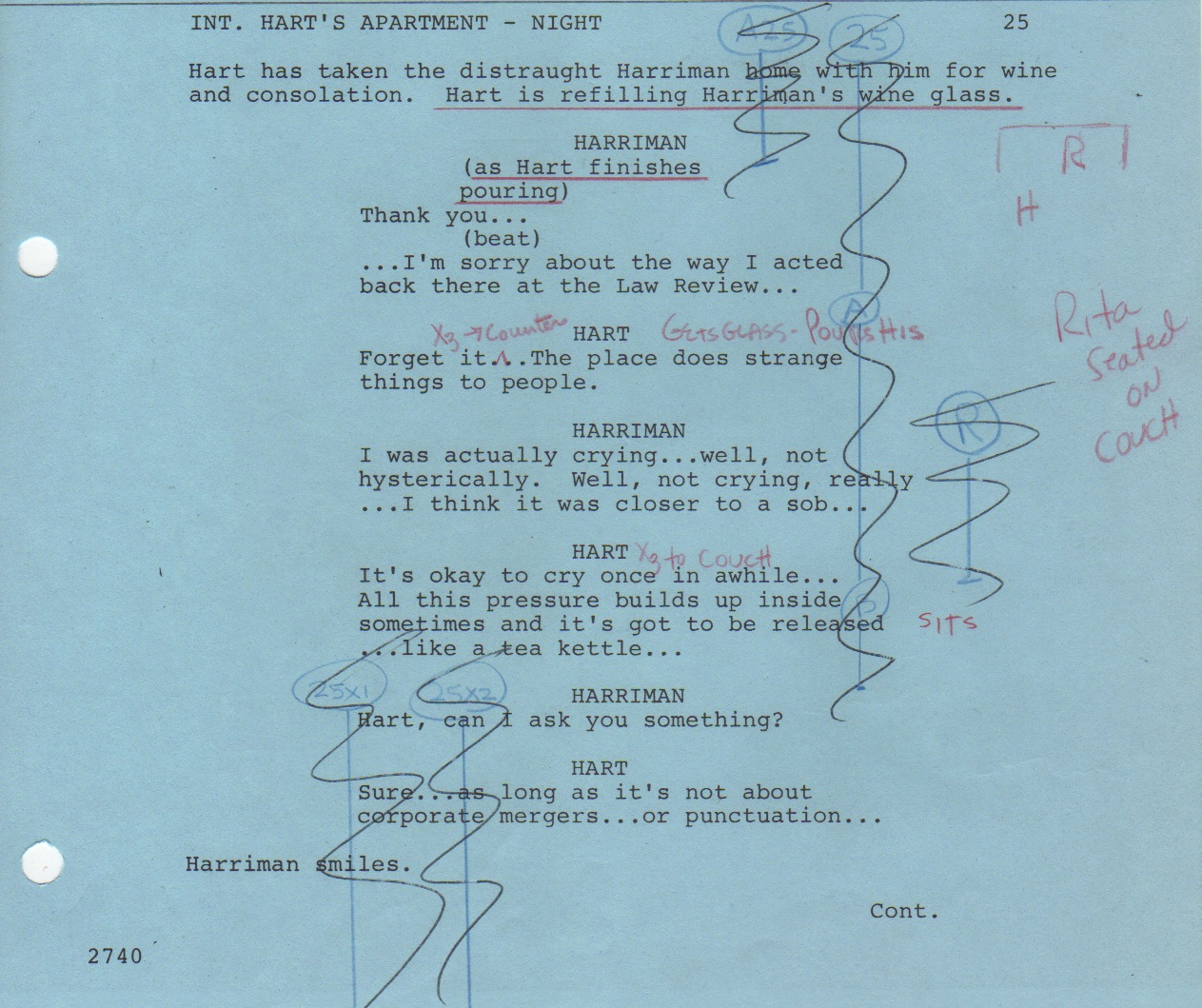
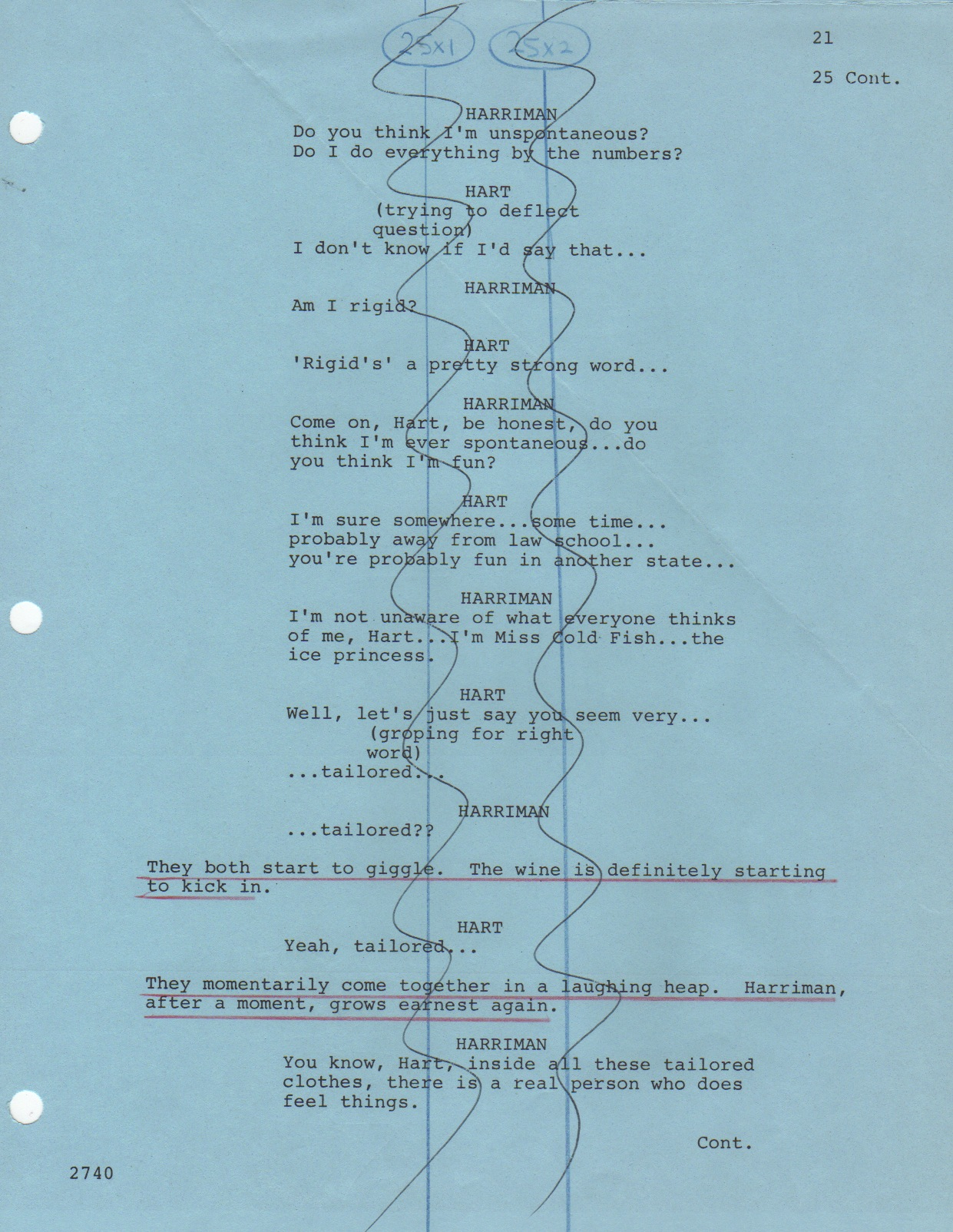
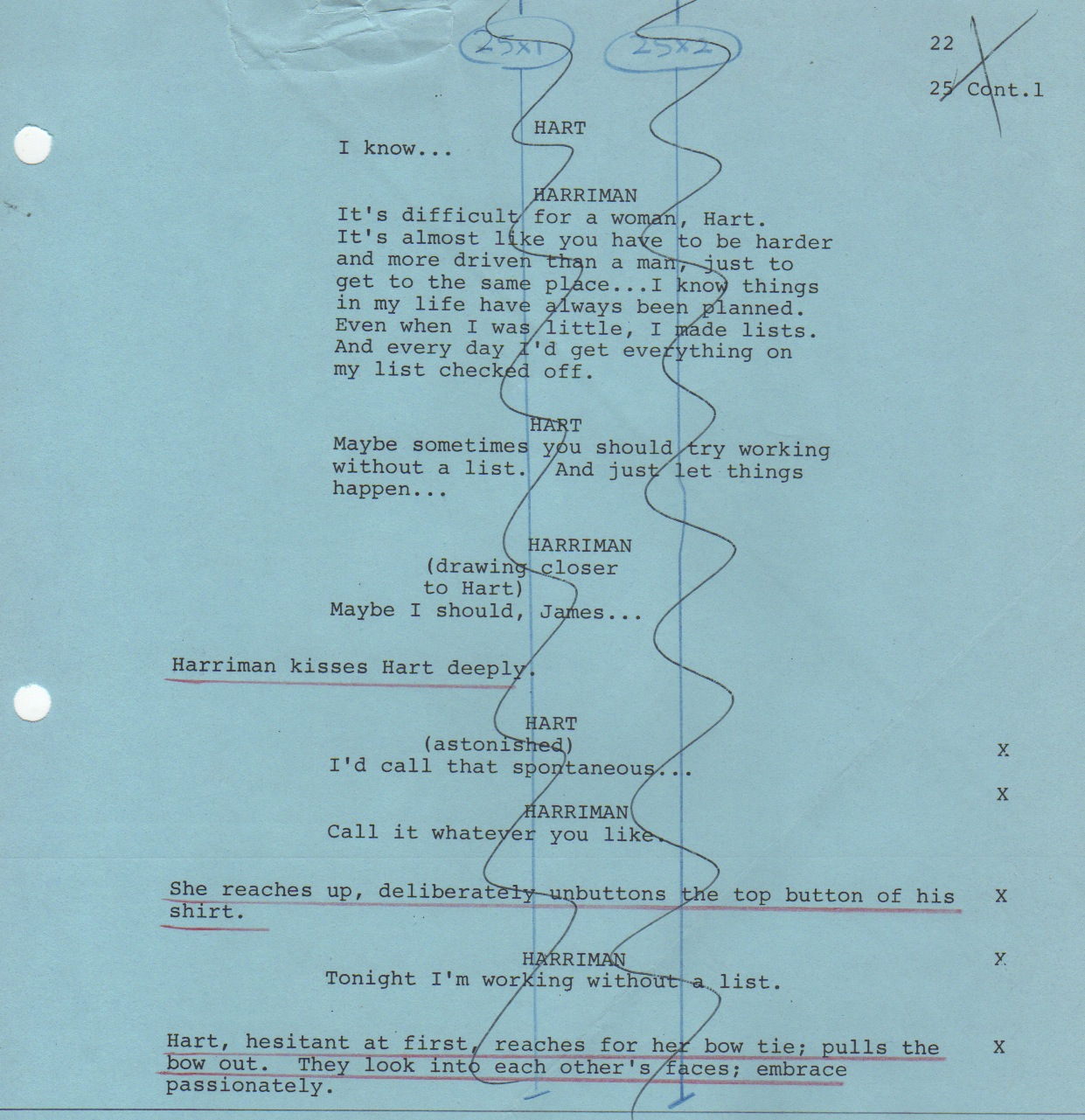
I did not attend dailies the following day because I was filming on location at the University of Southern California. Producer Ernie Losso came to me when I returned to the studio on the third day to tell me executive producer Lynn Roth and he didn’t think the scene between Hart and Harriman had been sexy enough. I couldn’t disagree, but I pointed out that scene started with a distraught Harriman’s abject apology for her erratic behavior at the Law Review earlier in the evening. It was that erratic behavior that built up to the sexual encounter…
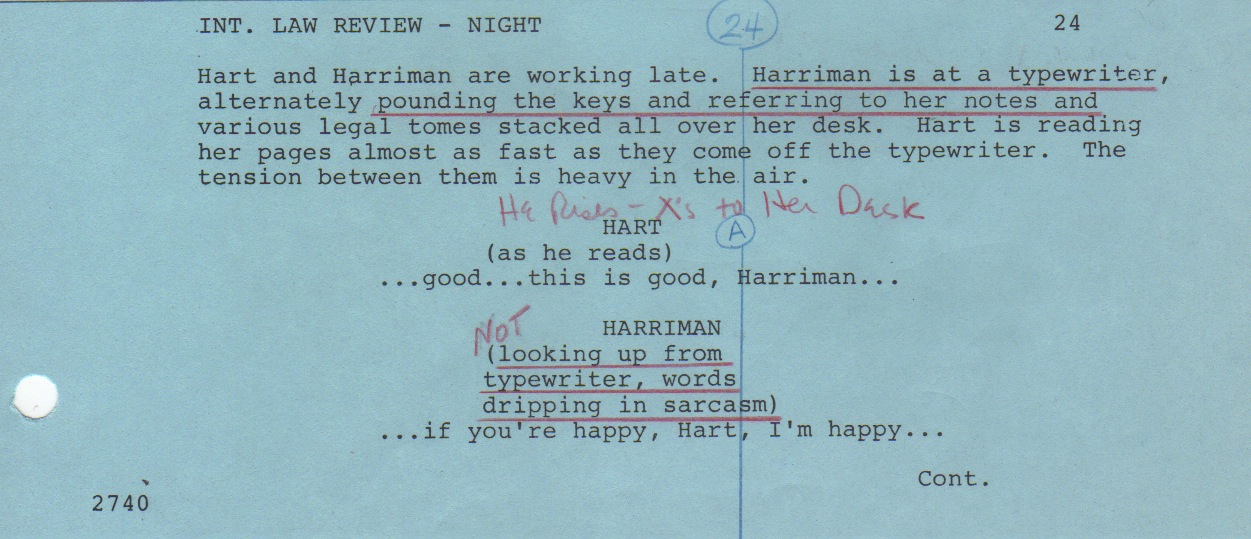
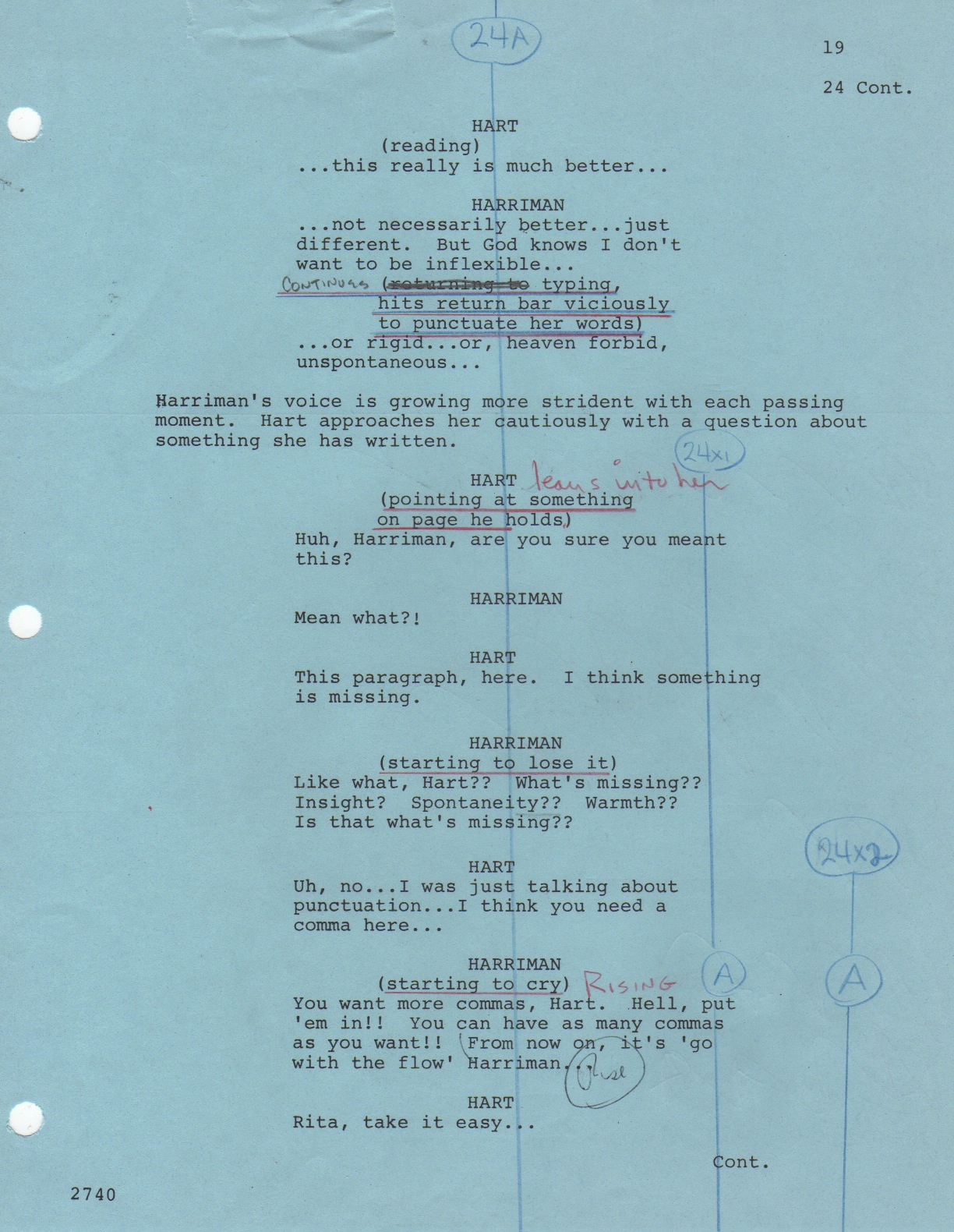
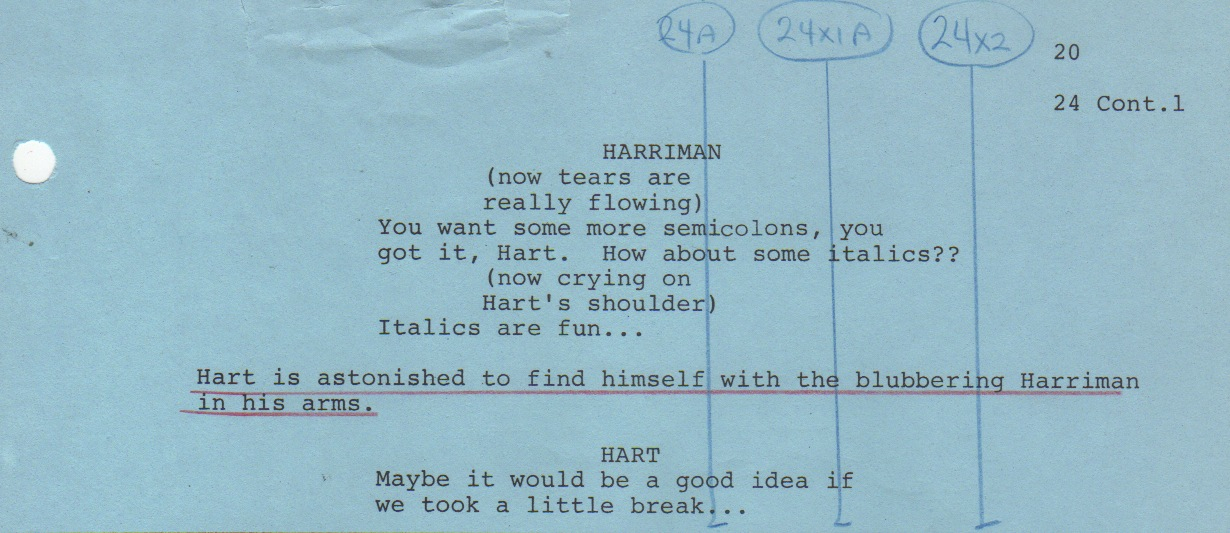
…and it had been a mistake to move the scene to Hart’s apartment for its conclusion. I thought the solution was to blend all of the material into one continuous scene and stage it at the Law Review. I would eliminate Harriman’s tears and Hart’s line, “Maybe it would be a good idea if we took a little break …, ” from the Law Review part of the scene and do some judicious editing at the beginning of the scene in the apartment. That would eliminate the cool down period that would have occurred as they moved from the Law Review to the apartment. Since the scene at the Law Review was scheduled for the next day, I said that I would make the necessary dialogue adjustments so that what was now two scenes would play as one. That’s what we filmed, and here it is.
I’m positive the author’s intent when he split the scene and wrote the second half in Hart’s apartment, he wanted to make it more inevitable they would end up in Hart’s bedroom. As you can see, that wasn’t really necessary, and there was an added bonus to our changes. The morning after scene is funnier.
And now that the Hart/Harriman affair has joined the Soloway lack of an affair in the realm of comedy, let’s get back and see what Soloway is up to.
That was the only time I worked with Mary-Robin Redd (the psychiatrist). She played one of the eight friends in the Vassar class of Sidney Lumet’s THE GROUP.
I felt the months I spent directing YOU CAN’T TAKE IT WITH YOU had been beneficial for me. I had deliberately directed the play more technically than I usually worked, having been told by Adrienne Marden about her experience being directed by George S. Kaufman in MERRILY WE ROLL ALONG. I figured if I was directing a Kaufman play, maybe I should try working the Kaufman method. She said he was totally technical, that everything – dialogue or stage business – was worked out to happen on the beat, on the count. I can’t say it changed my perceptions regarding directing, comedy or drama, but I know it sharpened my technique.
I have related elsewhere in my lengthy cinema trek the legendary story of writer George Seaton’s visits to Edmund Gwenn at the Motion Picture Home. One time as they sat talking, Gwenn said, “George, dying’s hard … (long pause) … but comedy’s harder.” My approach in directing comedy has always been to make it real, to let the humor come out of the reality of the situation rather than trying to do funny things. THE PAPER CHASE was a very serious, truly intellectual show. I felt A WOUNDED HART was a departure, at least for me, and many times it truly proved Gwenn’s words, “…comedy’s harder.”
The second day of filming on our six-day schedule was at USC. We reported to the studio at 6:00 am and were bused to the University. Interestingly 3 3/8 pages of our 7 5/8 pages day was night work. Since this was not a QM production, we were able to use our day for night filters in the camera, and if the early December nightfall came before we completed the day’s work, we were able to add lights to finish up.


